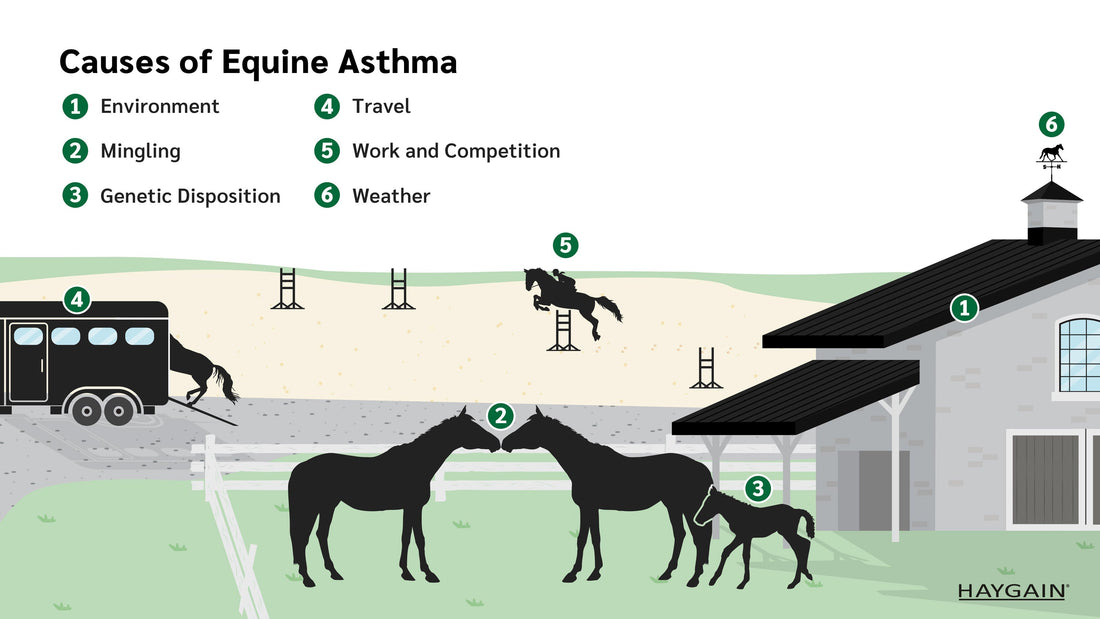05/08/2021
Equine Asthma Causes are Everywhere!
By Kim Miller | Equestrian Writer
Approximately 80% of active sport horses are challenged with some degree of Equine Asthma. Shocking as that may sound, it really shouldn't be given that causes of respiratory challenges exist in 100% of the environment and activities in which our horses live and participate.
Some horses have a genetic predisposition for asthma, but otherwise it's an occupational disease, explains sporthorse veterinarian Emmanuelle Van Erck-Westergren, DVM, PhD, ECEIM. "Environment, stresses of training and competition which can lower immunity, and mingling with other horses, are all risk factors for Equine Asthma."
The Environment
"Dust" is the innocent sounding description for the main causes of asthma. There's the dust you can see, and the dust you can't see -- under 5 microns in size and invisible without a microscope. Horses' natural respiratory defence mechanisms can usually handle larger particles. It's the invisible particles that pose the greatest risk because they can evade these defences and deliver tiny bits of mould, bacteria and other irritants and allergens deep into the lungs.
Unfortunately, even a meticulously maintained yard has loads of microscopic irritants, much of it from forage. That's true even when the forage has high nutrient value and looks and smells fresh and clean to a knowledgeable horseman.
That's why Dr. Van Erck-Westergren includes barn visits in caring for her patients, many of whom are referred for further study when respiratory challenges persist after traditional treatments.
"I look at the horse and his environment," explains the partner in the Equine Sports Medicine Practice in Waterloo, Belgium. "We do measurements of dust levels and samples of contaminants. Some are easy to see. Have you seen someone sweep dust from the barn aisle, then stash that in the horse's stall? Or seen mould stains on stable walls or ceilings?"
Sick Building Syndrome
"A condition called Sick Building Syndrome exists in human medicine and it can apply to horses, too," she continues. "They may not be coughing or having nasal discharge, but they clearly don't feel well. That can often be linked to the amount of contaminants growing inside the building.
"Horses were designed to live outside, but many horses spend 23 hours a day in the stable. Living inside, they're exposed to 50 times more inhalable irritants! Even if they live outside, if they're getting hay with contaminants, it's still a problem."
Even the weather can impact horse's respiratory health. In 2020, Dr. Van Erck-Westergren noted that Europe experienced particularly warm weather and earlier in the spring than normal. "That corresponded to a record number of respiratory cases, as did record pollen levels with record numbers of asthmatic patients.
"A Canadian study found a correlation between the temperature and humidity and worsening symptoms of equine asthma. And global warming is having an effect because there is a shorter or non-existent period when there is a layer of frozen ground. That all affects the number of contaminants, including fungi, mould and bacteria found in soil, in which hay or straw is grown."
Preventative Measures
"Assess and improve your horse's environment," Dr Van Erck-Westergren asserts, offering these four tips for horse owners:
1. Make sure there's ventilation in the barn. That means circulation and renewal of the air. If there's no renewal, moisture will accumulate and foster contaminant growth. Cobwebs indicate there isn't enough ventilation because spiders won't make them where there's any breeze.
2. Reduce dust: the fine dust that can be inhaled and lodge in the airways and deep in the lungs.
3. Look for signs of mould on walls, everywhere and especially on walls near stored hay.
4. Look at floor mats: specifically, what is growing between and underneath them. Urine accumulation can make it really dangerous and gross. It's awful for horses and people. Stables don't have to be sterile, but they do need to be clean."
Hay & Bedding
Two ubiquitous yard elements, hay and bedding, are major contributors to equine asthma. Dr. Westergren "strongly advises" all her clients to get a Haygain High Temperature Hay Steamer because it reduces up to 99% of the fine, respirable particles and kills fungi, bacteria and yeast in hay. Ample scientific studies demonstrate the benefits of killing the fungi/mould.
"When it comes to preventative medicine, high-temperature steaming is something that speaks for itself over time," she continues. "That's why you don't see many Haygain Hay Steamers for sale second-hand. Once horse owners adopt it, they don't go back."
As for bedding, first consider flooring that can be disinfected. ComfortStall Sealed Orthopaedic Flooring, by Haygain, is an ideal option that comes with built-in cushion so that bedding is only needed to absorb urine. Less bedding equals less respirable dust.
For what bedding is needed, wood shavings are good because they contain terpene, a natural anti-septic. Cardboard and paper shavings are cleaner options. Straw, however, can foster bacteria and fungal growth.
Beyond improving the air quality in the home barn, being mindful of equine asthma risks while away from home is equally important. Letting horses mingle with each other can transmit infectious respiratory diseases. Travel is prime time for inhaling harmful particles if horses have their nose tucked into unhygienic hay on the way.
Weather and genetic disposition are factors outside of the horse owner's control. But reducing respiratory risks in the horse's home and away environments can go a long way toward helping prevent Equine Asthma.
TRENDING ARTICLES



















